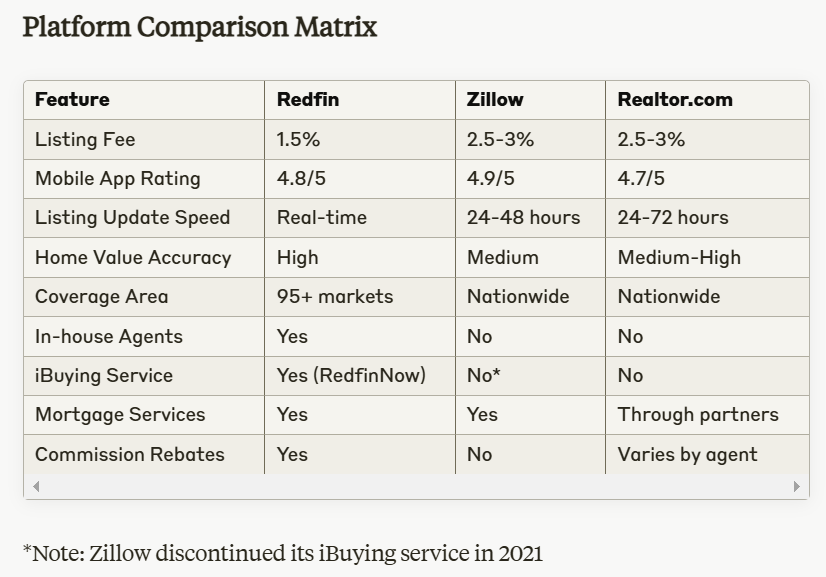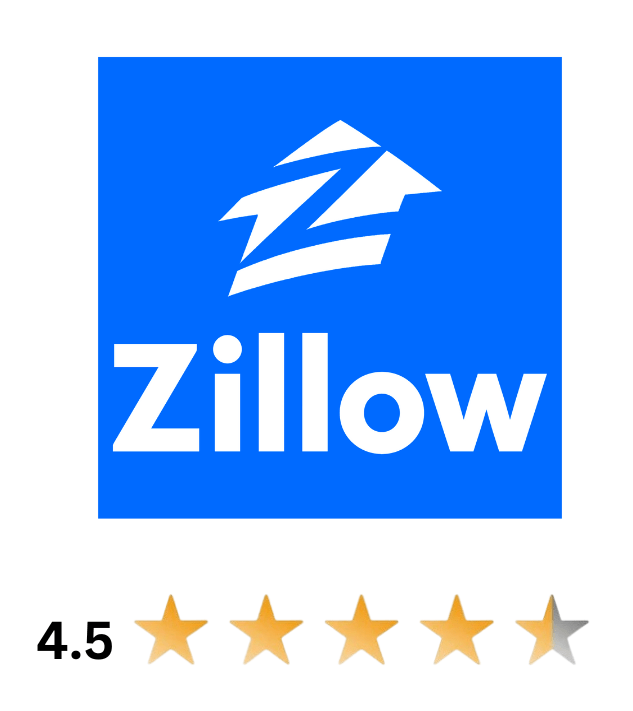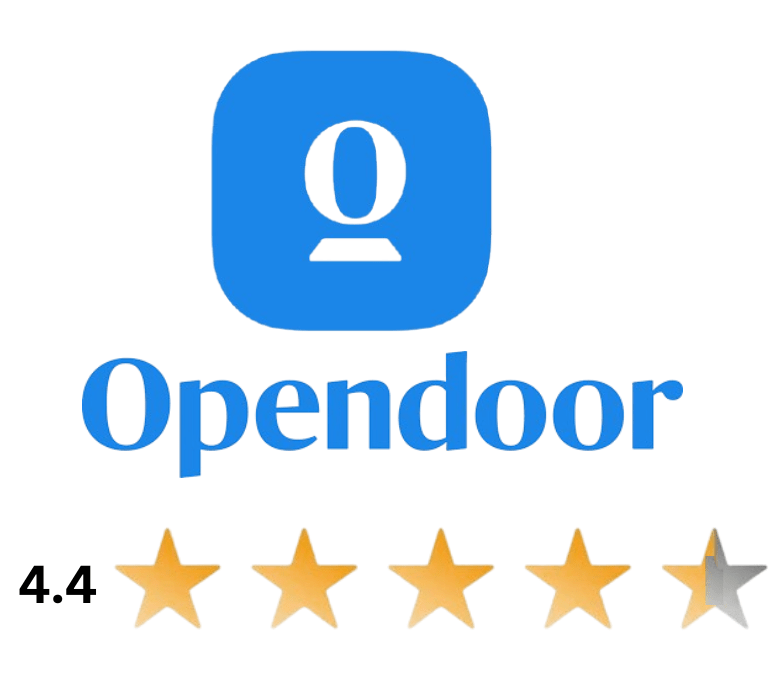If you’re considering buying or selling a home and want to understand how technology can make the process more efficient, then Redfin.com is a platform you’ll want to explore. As real estate moves into the digital age, Redfin combines tech innovation with professional services to deliver a seamless experience. In this review, we dive into what makes Redfin stand out, exploring its features, benefits, and what you should know before using it for your next property transaction.
Redfin.com, established in 2006, leverages technology with real-time updates, a top-rated app, and 3D tours. Its salaried agents focus on customer satisfaction, making it a more affordable and user-friendly real estate option.
This review is for anyone considering Redfin.com for real estate. We’ll cover its key features so you can decide if Redfin’s tech-driven approach fits your needs.

Table of Contents
ToggleWhat is Redfin?
Redfin.com is a reliable and legitimate real estate company that combines technology with traditional services to make buying, selling, and renting homes easier and more affordable. Founded in 2004, Redfin operates across many U.S. and Canadian markets, providing users with a platform that includes real-time property listings, virtual tours, and market insights. Its website and mobile app offer detailed property information and allow users to schedule tours and connect with agents, all aimed at simplifying the real estate experience.
What sets Redfin.com apart is its unique agent model. Unlike traditional brokerages where agents work on commission, Redfin’s agents are salaried and focus on customer satisfaction. This means they’re motivated to provide helpful, straightforward service rather than just making a sale. For sellers, Redfin charges a 1.5% listing fee, lower than typical commission rates, which can lead to significant savings.
Pros and Cons of Redfin.com:
Pros👍
- Lower Commission Fees: Redfin typically charges 1.5% listing fee compared to traditional 2.5-3% fees
- Tech-Enhanced Experience: Advanced search filters, 3D walkthroughs, and AI-powered home estimates
- Transparent Pricing: Clear fee structure and potential savings calculator upfront
- Integrated Services: One-stop shop for buying, selling, mortgages, and title services
- Real-Time Updates: Immediate notifications for new listings and price changes
- Virtual Tours: Comprehensive 3D home tours and virtual open houses
Cons👎
- Limited Personal Attention: Team-based approach means less one-on-one time with a dedicated agent
- Variable Service Quality: Experience can differ significantly between markets
- Coverage Limitations: Not available in all markets, especially rural areas
- High-Volume Business Model: Agents handle more clients than traditional realtors
Who is Redfin for?
Redfin.com is ideal for tech-savvy home buyers who enjoy a digital approach to real estate. Its intuitive website and app offer detailed property listings, accurate pricing data, and virtual tour options, making online home searching easy and comprehensive.
Cost-conscious sellers will appreciate Redfin’s lower commission rates, which start at 1.5%, compared to the typical 2.5-3%. This helps sellers save on fees without compromising on professional services and marketing support.
Redfin’s data-rich platform is perfect for buyers and sellers who value data-driven decisions. With in-depth market analytics and reliable home valuations, Redfin provides the insights users need to make smart, informed choices in real estate.
Who Redfin Might Not Be Ideal For?
Redfin.com might not be the best choice for people who prefer a more traditional real estate experience with plenty of personal attention. With Redfin’s tech-focused and team-based approach, it can sometimes feel less personal than a traditional real estate agency where you work closely with a dedicated agent from start to finish. If you’re used to having a single point of contact who guides you closely throughout the process, Redfin’s model may not fully meet your expectations.
Additionally, Redfin.com primarily serves urban and suburban areas, which means it may not be ideal for buyers or sellers dealing with rural properties. If you’re interested in buying or selling in a more remote or rural location, you may find that Redfin’s services are limited or even unavailable in those areas.
How Does Redfin.com Work?
Redfin.com takes a simple, tech-focused approach to real estate that appeals to both buyers and sellers.
For buyers:
the platform offers a user-friendly search tool with real-time MLS listings, ensuring up-to-date information on available homes. Scheduling tours is easy, thanks to the website and app, which streamline the process. Plus, Redfin’s “buyer rebate” can mean extra savings, with the chance to get back part of the agent’s commission. Redfin also includes digital tools like 3D home walkthroughs, interactive maps, and neighborhood insights, helping buyers make more confident choices.
For sellers:
Redfin.com provides professional marketing services to showcase homes effectively. Their listing process includes high-quality photos, 3D scans, and custom marketing materials that help homes stand out. Redfin’s pricing strategy is also data-driven, using proprietary algorithms to suggest competitive prices based on market trends.
Special Features of Redfin.com:
Redfin offers a variety of features and services designed to streamline the home buying and selling process:
RedfinNow:
This is Redfin’s iBuyer program, where Redfin directly buys homes from sellers, making the selling process faster and more convenient. Sellers can receive a cash offer from RedfinNow, close quickly, and avoid the hassle of listing on the open market. However, service fees may apply, and offers could be slightly lower than a traditional sale due to the convenience and speed factor.
Redfin Mortgage:
This service provides mortgage solutions for home buyers, directly from Redfin. It offers competitive rates, a streamlined online application process, and personalized support to help buyers understand their mortgage options and get pre-approved for loans.
Redfin Estimate:
This is Redfin’s proprietary home valuation tool, giving an estimate of a property’s value based on a variety of data points, including market trends and recent sale prices of similar homes. It’s updated frequently to reflect current market conditions, giving buyers and sellers a rough idea of a home’s worth, though it may not be as precise as an official appraisal.
Pricing Structure
Redfin offers a distinctive pricing structure for both sellers and buyers, aiming to provide cost-effective real estate services.
Seller Fees:
- Listing Fee: Redfin charges a standard listing fee of 1.5% of the home’s sale price, which is lower than the typical 2.5–3% fees charged by traditional brokerages.
- Buyer’s Agent Commission: In addition to the listing fee, sellers are generally responsible for paying the buyer’s agent commission, which typically ranges from 2.5% to 3%.
- Total Commission: Combining both fees, the total commission paid by the seller usually amounts to 4–4.5% of the sale price, offering potential savings compared to the traditional 5–6% total commission.
Buyer Costs:
- Commission Fees: Buyers typically do not pay their agent’s commission directly; instead, the seller covers this cost as part of the transaction.
- Closing Costs: Buyers are responsible for closing costs, which generally range from 2% to 5% of the home’s purchase price. These costs include expenses such as loan origination fees, appraisal fees, and title insurance.
- Redfin Refund: In certain markets, Redfin offers a buyer refund program, providing a portion of the buyer’s agent commission back to the buyer at closing. The availability and amount of this refund can vary, so it’s advisable to consult with a Redfin agent for specific details.
Best alternatives:


Zillow is one of the most well-known online real estate platforms. It offers similar features to Redfin, including home listings, price estimates (via its “Zestimate”), and buying/selling tools. Zillow also operates Zillow Offers, an iBuyer program that allows homeowners to receive cash offers for their homes, bypassing traditional market listing. Zillow provides a wealth of resources for both buyers and sellers, such as mortgage calculators and agent connections.

Opendoor is a leading iBuyer platform, offering homeowners the ability to sell their homes directly to the company. Opendoor provides a fast, hassle-free selling process with cash offers and a quick closing timeline, similar to RedfinNow. They also offer services for buyers, allowing them to browse listings and book home tours online. Opendoor focuses on simplifying the home transaction process, especially in competitive real estate markets.

Realtor.com is another major player in the real estate space, providing an extensive listing database that includes both homes for sale and rental properties. It offers detailed property information, including pricing history, photos, and virtual tours. Realtor.com is an official listing site of the National Association of Realtors (NAR), and it provides access to local MLS data, which can sometimes offer more up-to-date listings than other platforms. Realtor.com also provides home value estimates and tools for connecting with real estate agents.
Bottom Line
Redfin has successfully disrupted the traditional real estate model by combining technology with reduced fees. Their platform offers excellent value for tech-savvy users who prioritize savings and digital tools over traditional agent relationships. With over 1% market share in the U.S. residential real estate market and consistent growth, Redfin has proven its model works for many consumers.
The platform’s strength lies in its technology integration and cost savings, but potential users should weigh these benefits against their personal needs for traditional agent services. For those comfortable with a more digital approach to real estate transactions, Redfin offers a compelling alternative to traditional brokerages.



